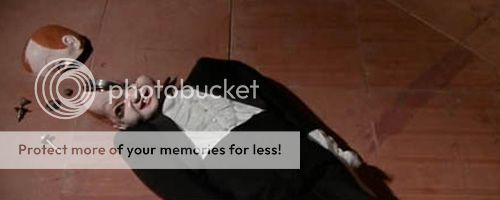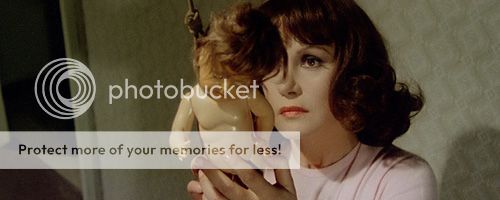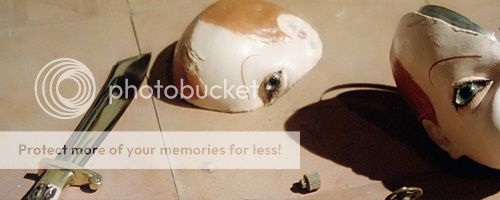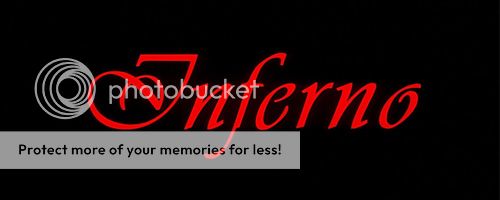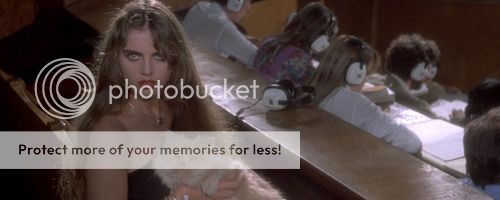- Joined
- May 21, 2011
- Messages
- 25,385
- Reaction score
- 889
- Points
- 118
- Age
- 47
- Favorite Wrestler
-

- Favorite Wrestler
-

- Favorite Wrestler
-

- Favorite Wrestler
-

Re: The Wing Kong Exchange (feat. Tenebre)
A young American dancer travels to Europe to join a famous ballet school. As she arrives, she sees another student seem to flee from the school, only to be murdered a short time later. Meanwhile, the young American is trying to settle in at the ballet school, but hears strange noises and is troubled by bizarre occurrences. She eventually discovers that the school is merely a front for a much more sinister organization, a coven of witches.
Suspiria, released in 1977, is most likely Dario Argento’s masterpiece, a kaleidoscope of horror and a landmark achievement in Italian cinema. Unlike the accessible Tenebre, Suspiria does its level best to mess with the audiences minds, attempting to create a surreal film the likes of which would impress Luis Bunuel or Salvador Dali. Amazingly, more often than not it manages to do this while still maintaining some semblance of a straight-forward plot and a proper pace. While he had previously dabbled in giallo works such as The Bird with the Crystal Plumage and Four Flies on Grey Velvet, Suspiria was Argento’s first foray into straight up horror, and he certainly doesn’t disappoint. Using his trademark visceral style, he masterfully crafts not only a film with a great deal of tension and horror, but one with a flair for the dramatic as well. Long considered one of the scariest films ever made, it is just as powerful now as it must have been 35 years ago, which is no small feat considering its bizarre qualities. Beyond anything else, if any film proved that Dario Argento was an undisputed master of horror, it was most certainly Suspiria.
Argento directed and co-wrote with his muse, Daria Nicolidi, and the result of their collaboration is absolute horror gold. As with many of his other films, Argento has a very deliberate style on display here, from the very beginning to the final shot. His choice and use of colours is excellent, bathing some rooms in stark red’s and white’s while alternately showing others in dark blues or bright yellows. Each of these colours holds a special purpose in the twisted lens of Argento, yet it appears that only he understands why each is used and when. He also resorts to some of his classic camera angles, which only further add to the surreal qualities throughout the film. I was particularly impressed with most of his blocking and framing as well, as almost every shot in the film looks incredible when paused. Meanwhile, the screenplay is actually pretty logical when you sit back and think about it, and there’s barely any wasted dialogue or scenarios. Even events that don’t necessarily seem to mean anything at one point all come back and are explained by the end, something that doesn’t always happen in Italian cinema. Cohesiveness was definitely the key here, and it was mastered by both Argento and Nicolidi, resulting in a full and complete film.
Jessica Harper is cast in the lead role of Suzy Bannion, the American ballet dancer who has absolutely no clue what she’s getting herself into by attending the school. For the most part, she does an exceptional job at portraying a headstrong, resourceful final girl although there are moments where her acting inexperience comes through. Luckily Argento is so busy doing nasty things to her and the other students that you don’t tend to notice any major shortcomings in her performance. Horror veteran Udo Kier pops up in a brief role as a creepy doctor, while noted foreign actress Alida Valli has some scene stealing moments as an instructor at the school and one of the witches. Speaking of them, the others are great as well, with Joan Bennet in particular giving a strong showing as Madame Blanc. Perhaps my favourite work in the film comes from Flavio Bucci, who plays the blind pianist at the school, Daniel. His scene where he’s unceremoniously fired is superb as is his subsequent murder in the square. Finally, I just have to mention Giuseppe Transocchi’s bit part as Pavlo, the hired hand at the school, because he’s just so freaky looking I couldn’t get him out of my head for quite some time after watching the movie!
Make no mistake, Suspiria is completely and totally insane on every level, and awash in violence and bloodshed like few films you’ve seen before. As per usual, Argento wastes no time wiping out his first hapless victim, repeadtedly stabbing her before elaborately hanging her through a shattered stained glass window. Later on we’ve got a character killed and eaten by a dog, more maggots than I’d ever care to see again in my life and a scene that will really make you look at barbed wire in a totally new light. Through all of this, he keeps the horror at a maximum through both the above-mentioned camera and lighting techniques and the use of Goblin’s rich soundtrack. While Tenebre had some pretty cool tunes, Suspiria’s score is simply off the charts, with no less than three songs becoming instantly engrained in your head. They also add so much to the movie in order to make it even scarier than it already was which certainly goes to show that the songs were used effectively. If there’s one major problem with this movie, it’s that it seems to end rather abruptly and leave the audience wanting more. The fact that prior to that it was one of the most abhorrent and despicable bloodbath’s I’ve ever seen makes me worry about my sanity given I wanted to see more, but I’m going to go with it because that’s how I roll!
Alright, so it’s not quite as accessible as Tenebre, but overall I think Suspiria is the better film. Not having seen it for so long gave me an almost instant re-appreciation for it and I truly believe that it’s Dario Argento’s masterpiece and a very important work of horror. It’s certainly not for everyone, least of all the squeamish, but if you can stomach the violence and your brain can take the craziness, you’ll definitely find it kicking all kinds of ass. We’ve still got a few more Argento films to get to before we’re done, but I can’t see any topping this one so I’m going 8.5/10 and jumping into a pit full of barbed wire until tomorrow.
Thanks buddy, if I can grab a decent sized copy of it I'll upload it here later on. In the meantime, here's another one you may not have heard of but should definitely check out....I have not heard of this film but after reading Fuji's glowing review I will have to find it. I just hope I don't get a high heel in my face.
Sent From My Awesome EVO 3-D.
A young American dancer travels to Europe to join a famous ballet school. As she arrives, she sees another student seem to flee from the school, only to be murdered a short time later. Meanwhile, the young American is trying to settle in at the ballet school, but hears strange noises and is troubled by bizarre occurrences. She eventually discovers that the school is merely a front for a much more sinister organization, a coven of witches.
Suspiria, released in 1977, is most likely Dario Argento’s masterpiece, a kaleidoscope of horror and a landmark achievement in Italian cinema. Unlike the accessible Tenebre, Suspiria does its level best to mess with the audiences minds, attempting to create a surreal film the likes of which would impress Luis Bunuel or Salvador Dali. Amazingly, more often than not it manages to do this while still maintaining some semblance of a straight-forward plot and a proper pace. While he had previously dabbled in giallo works such as The Bird with the Crystal Plumage and Four Flies on Grey Velvet, Suspiria was Argento’s first foray into straight up horror, and he certainly doesn’t disappoint. Using his trademark visceral style, he masterfully crafts not only a film with a great deal of tension and horror, but one with a flair for the dramatic as well. Long considered one of the scariest films ever made, it is just as powerful now as it must have been 35 years ago, which is no small feat considering its bizarre qualities. Beyond anything else, if any film proved that Dario Argento was an undisputed master of horror, it was most certainly Suspiria.
Argento directed and co-wrote with his muse, Daria Nicolidi, and the result of their collaboration is absolute horror gold. As with many of his other films, Argento has a very deliberate style on display here, from the very beginning to the final shot. His choice and use of colours is excellent, bathing some rooms in stark red’s and white’s while alternately showing others in dark blues or bright yellows. Each of these colours holds a special purpose in the twisted lens of Argento, yet it appears that only he understands why each is used and when. He also resorts to some of his classic camera angles, which only further add to the surreal qualities throughout the film. I was particularly impressed with most of his blocking and framing as well, as almost every shot in the film looks incredible when paused. Meanwhile, the screenplay is actually pretty logical when you sit back and think about it, and there’s barely any wasted dialogue or scenarios. Even events that don’t necessarily seem to mean anything at one point all come back and are explained by the end, something that doesn’t always happen in Italian cinema. Cohesiveness was definitely the key here, and it was mastered by both Argento and Nicolidi, resulting in a full and complete film.
Jessica Harper is cast in the lead role of Suzy Bannion, the American ballet dancer who has absolutely no clue what she’s getting herself into by attending the school. For the most part, she does an exceptional job at portraying a headstrong, resourceful final girl although there are moments where her acting inexperience comes through. Luckily Argento is so busy doing nasty things to her and the other students that you don’t tend to notice any major shortcomings in her performance. Horror veteran Udo Kier pops up in a brief role as a creepy doctor, while noted foreign actress Alida Valli has some scene stealing moments as an instructor at the school and one of the witches. Speaking of them, the others are great as well, with Joan Bennet in particular giving a strong showing as Madame Blanc. Perhaps my favourite work in the film comes from Flavio Bucci, who plays the blind pianist at the school, Daniel. His scene where he’s unceremoniously fired is superb as is his subsequent murder in the square. Finally, I just have to mention Giuseppe Transocchi’s bit part as Pavlo, the hired hand at the school, because he’s just so freaky looking I couldn’t get him out of my head for quite some time after watching the movie!
Make no mistake, Suspiria is completely and totally insane on every level, and awash in violence and bloodshed like few films you’ve seen before. As per usual, Argento wastes no time wiping out his first hapless victim, repeadtedly stabbing her before elaborately hanging her through a shattered stained glass window. Later on we’ve got a character killed and eaten by a dog, more maggots than I’d ever care to see again in my life and a scene that will really make you look at barbed wire in a totally new light. Through all of this, he keeps the horror at a maximum through both the above-mentioned camera and lighting techniques and the use of Goblin’s rich soundtrack. While Tenebre had some pretty cool tunes, Suspiria’s score is simply off the charts, with no less than three songs becoming instantly engrained in your head. They also add so much to the movie in order to make it even scarier than it already was which certainly goes to show that the songs were used effectively. If there’s one major problem with this movie, it’s that it seems to end rather abruptly and leave the audience wanting more. The fact that prior to that it was one of the most abhorrent and despicable bloodbath’s I’ve ever seen makes me worry about my sanity given I wanted to see more, but I’m going to go with it because that’s how I roll!
Alright, so it’s not quite as accessible as Tenebre, but overall I think Suspiria is the better film. Not having seen it for so long gave me an almost instant re-appreciation for it and I truly believe that it’s Dario Argento’s masterpiece and a very important work of horror. It’s certainly not for everyone, least of all the squeamish, but if you can stomach the violence and your brain can take the craziness, you’ll definitely find it kicking all kinds of ass. We’ve still got a few more Argento films to get to before we’re done, but I can’t see any topping this one so I’m going 8.5/10 and jumping into a pit full of barbed wire until tomorrow.









